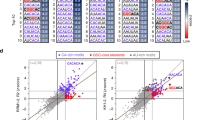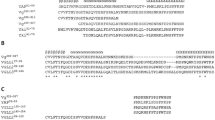Abstract
Although the abundant sterile alpha motif (SAM) domain was originally classified as a protein-protein interaction domain, it has recently been shown that certain SAM domains have the ability to bind RNA, defining a new type of post-transcriptional gene regulator. To further understand the function of SAM-RNA recognition, we determined the solution structures of the SAM domain of the Saccharomyces cerevisiae Vts1p (Vts1p-SAM) and the Smaug response element (SRE) stem-loop RNA as a complex and in isolation. The structures show that Vts1p-SAM recognizes predominantly the shape of the SRE rather than its sequence, with the exception of a G located at the tip of the pentaloop. Using microarray gene profiling, we identified several genes in S. cerevisiae that seem to be regulated by Vts1p and contain one or more copies of the SRE.
This is a preview of subscription content, access via your institution
Access options
Subscribe to this journal
Receive 12 print issues and online access
$189.00 per year
only $15.75 per issue
Buy this article
- Purchase on Springer Link
- Instant access to full article PDF
Prices may be subject to local taxes which are calculated during checkout





Similar content being viewed by others
References
Qiao, F. & Bowie, J.U. The many faces of SAM. Sci. STKE [online] 2005, re7 (2005) (10.1126/stke.2862005re7).
Hall, T.M. SAM breaks its stereotype. Nat. Struct. Biol. 10, 677–679 (2003).
Sharrocks, A.D. The ETS-domain transcription factor family. Nat. Rev. Mol. Cell Biol. 2, 827–837 (2001).
Jousset, C. et al. A domain of TEL conserved in a subset of ETS proteins defines a specific oligomerization interface essential to the mitogenic properties of the TEL-PDGFR beta oncoprotein. EMBO J. 16, 69–82 (1997).
Yu, X., West, S.C. & Egelman, E.H. Structure and subunit composition of the RuvAB-Holliday junction complex. J. Mol. Biol. 266, 217–222 (1997).
Aviv, T. et al. The RNA-binding SAM domain of Smaug defines a new family of post-transcriptional regulators. Nat. Struct. Biol. 10, 614–621 (2003).
Green, J.B., Gardner, C.D., Wharton, R.P. & Aggarwal, A.K. RNA recognition via the SAM domain of Smaug. Mol. Cell 11, 1537–1548 (2003).
Dilcher, M., Kohler, B. & von Mollard, G.F. Genetic interactions with the yeast Q-SNARE VTI1 reveal novel functions for the R-SNARE YKT6. J. Biol. Chem. 276, 34537–34544 (2001).
Smibert, C.A., Wilson, J.E., Kerr, K. & Macdonald, P.M. smaug protein represses translation of unlocalized nanos mRNA in the Drosophila embryo. Genes Dev. 10, 2600–2609 (1996).
Dahanukar, A., Walker, J.A. & Wharton, R.P. Smaug, a novel RNA-binding protein that operates a translational switch in Drosophila. Mol. Cell 4, 209–218 (1999).
Nelson, M.R., Leidal, A.M. & Smibert, C.A. Drosophila Cup is an eIF4E-binding protein that functions in Smaug-mediated translational repression. EMBO J. 23, 150–159 (2004).
Semotok, J.L. et al. Smaug recruits the CCR4/POP2/NOT deadenylase complex to trigger maternal transcript localization in the early Drosophila embryo. Curr. Biol. 15, 284–294 (2005).
Tucker, M., Staples, R.R., Valencia-Sanchez, M.A., Muhlrad, D. & Parker, R. Ccr4p is the catalytic subunit of a Ccr4p/Pop2p/Notp mRNA deadenylase complex in Saccharomyces cerevisiae. EMBO J. 21, 1427–1436 (2002).
Chen, J., Chiang, Y.C. & Denis, C.L. CCR4, a 3′-5′ poly(A) RNA and ssDNA exonuclease, is the catalytic component of the cytoplasmic deadenylase. EMBO J. 21, 1414–1426 (2002).
Moore, P.B. Structural motifs in RNA. Annu. Rev. Biochem. 68, 287–300 (1999).
Hofacker, I.L. Vienna RNA secondary structure server. Nucleic Acids Res. 31, 3429–3431 (2003).
Qiao, F. et al. Derepression by depolymerization; structural insights into the regulation of Yan by Mae. Cell 118, 163–173 (2004).
Thanos, C.D., Goodwill, K.E. & Bowie, J.U. Oligomeric structure of the human EphB2 receptor SAM domain. Science 283, 833–836 (1999).
Stefl, R., Skrisovska, L. & Allain, F.H. RNA sequence- and shape-dependent recognition by proteins in the ribonucleoprotein particle. EMBO Rep. 6, 33–38 (2005).
Wu, H., Henras, A., Chanfreau, G. & Feigon, J. Structural basis for recognition of the AGNN tetraloop RNA fold by the double-stranded RNA-binding domain of Rnt1p RNase III. Proc. Natl. Acad. Sci. USA 101, 8307–8312 (2004).
Lu, D., Searles, M.A. & Klug, A. Crystal structure of a zinc-finger-RNA complex reveals two modes of molecular recognition. Nature 426, 96–100 (2003).
Williamson, J.R. Induced fit in RNA-protein recognition. Nat. Struct. Biol. 7, 834–837 (2000).
Maris, C., Dominguez, C. & Allain, F.H. The RNA recognition motif, a plastic RNA-binding platform to regulate post-transcriptional gene expression. FEBS J. 272, 2118–2131 (2005).
DeRisi, J.L., Iyer, V.R. & Brown, P.O. Exploring the metabolic and genetic control of gene expression on a genomic scale. Science 278, 680–686 (1997).
Collart, M.A. & Timmers, H.T. The eukaryotic Ccr4-not complex: a regulatory platform integrating mRNA metabolism with cellular signaling pathways? Prog. Nucleic Acid Res. Mol. Biol. 77, 289–322 (2004).
Denis, C.L. & Chen, J. The CCR4-NOT complex plays diverse roles in mRNA metabolism. Prog. Nucleic Acid Res. Mol. Biol. 73, 221–250 (2003).
Sattler, M., Schleucher, J. & Griesinger, C. Heteronuclear multidimensional NMR experiments for the structure determination of proteins in solution employing pulsed field gradients. Prog. Nucl. Magn. Reson. Spectrosc. 34, 93–158 (1999).
Bax, A., Kontaxis, G. & Tjandra, N. Dipolar couplings in macromolecular structure determination. Methods Enzymol. 339, 127–174 (2001).
Peterson, R.D., Theimer, C.A., Wu, H. & Feigon, J. New applications of 2D filtered/edited NOESY for assignment and structure elucidation of RNA and RNA-protein complexes. J. Biomol. NMR 28, 59–67 (2004).
Zwahlen, C. et al. Method for measurement of intermolecular NOEs by multinuclear NMR spectrocopy:application to a bacteriophage lambda N-peptide/boxB RNA complex. J. Am. Chem. Soc. 119, 6711–6721 (1997).
Herrmann, T., Guntert, P. & Wuthrich, K. Protein NMR structure determination with automated NOE assignment using the new software CANDID and the torsion angle dynamics algorithm DYANA. J. Mol. Biol. 319, 209–227 (2002).
Guntert, P., Mumenthaler, C. & Wuthrich, K. Torsion angle dynamics for NMR structure calculation with the new program DYANA. J. Mol. Biol. 273, 283–298 (1997).
Case, D.A. et al. AMBER Version 7 (University of California, San Francisco, USA, 2002).
Cornell, W.D. et al. A 2nd generation force-field for the simulation of proteins, nucleic-acids, and organic-molecules. J. Am. Chem. Soc. 117, 5179–5197 (1995).
Bashford, D. & Case, D. Generalized born models of macromolecular solvation effects. Annu. Rev. Phys. Chem. 51, 129–152 (2000).
Padrta, P., Stefl, R., Kralik, L., Zidek, L. & Sklenar, V. Refinement of d(GCGAAGC) hairpin structure using one- and two-bond residual dipolar couplings. J. Biomol. NMR 24, 1–14 (2002).
Tsui, V., Zhu, L., Huang, T.H., Wright, P.E. & Case, D.A. Assessment of zinc finger orientations by residual dipolar coupling constants. J. Biomol. NMR 16, 9–21 (2000).
Laskowski, R.A., Rullmannn, J.A., MacArthur, M.W., Kaptein, R. & Thornton, J.M. AQUA and PROCHECK-NMR: programs for checking the quality of protein structures solved by NMR. J. Biomol. NMR 8, 477–486 (1996).
Koradi, R., Billeter, M. & Wuthrich, K. MOLMOL: a program for display and analysis of macromolecular structures. J. Mol. Graph. 14, 29–32, 51–55 (1996).
DeLano, W.L. The PyMOL Molecular Graphics System (DeLano Scientific, San Carlos, California, USA, 2002).
Lee, A., Henras, A.K. & Chanfreau, G. Multiple RNA surveillance pathways limit aberrant expression of iron uptake mRNAs and prevent iron toxicity in S. cerevisiae. Mol. Cell 19, 39–51 (2005).
Kellis, M., Patterson, N., Endrizzi, M., Birren, B. & Lander, E.S. Sequencing and comparison of yeast species to identify genes and regulatory elements. Nature 423, 241–254 (2003).
Duchow, H.K., Brechbiel, J.L., Chatterjee, S. & Gavis, E.R. The nanos translational control element represses translation in somatic cells by a Bearded box-like motif. Dev. Biol. 282, 207–217 (2005).
Mulder, F.A., Schipper, D., Bott, R. & Boelens, R. Altered flexibility in the substrate-binding site of related native and engineered high-alkaline Bacillus subtilisins. J. Mol. Biol. 292, 111–123 (1999).
Ariyoshi, M., Nishino, T., Iwasaki, H., Shinagawa, H. & Morikawa, K. Crystal structure of the holliday junction DNA in complex with a single RuvA tetramer. Proc. Natl. Acad. Sci. USA 97, 8257–8262 (2000).
Acknowledgements
We are grateful to Y. Barral, Institute of Biochemistry, Swiss Federal Institute of Technology in Zurich, for providing the yeast genomic DNA for cloning and to S. Pitsch, L. Reymond and P. Wenter, Ecole Polytechnique Fédérale de Lausanne, for chemical synthesis of the 13C sugar-labeled RNAs. We thank the University of California at Los Angeles Microarray Core Facility for help with microarray experiments. This investigation was supported by a predoctoral fellowship from the Roche Research Foundation for Biology to F.C.O., the American Heart Association Western States Affiliate (A.L.), a Human Frontier Science Program postdoctoral fellowship to R.S., a US National Science Foundation IGERT DGE grant to M.J., US National Institutes of Health grant GM 61518 to G.C. and grants from the Swiss National Science Foundation, the Structural Biology National Center of Competence in Research and the Roche Research Fund for Biology at the Swiss Federal Institute of Technology in Zurich to F.H.-T.A. F.H.-T.A. is a European Molecular Biology Organization Young Investigator.
Author information
Authors and Affiliations
Corresponding author
Ethics declarations
Competing interests
The authors declare no competing financial interests.
Supplementary information
Supplementary Fig. 1
Chemical shift differences upon complexation of Vts1p-SAM and the SRE RNA. (PDF 489 kb)
Supplementary Fig. 2
Structure ensembles of the free Vts1p-SAM domain, the free RNA and their complex. (PDF 3429 kb)
Supplementary Fig. 3
13C-1H HSQC spectra of two sugar-labeled SRE RNAs in their bound state. (PDF 1090 kb)
Supplementary Fig. 4
Binding studies of mutant SRE RNAs. (PDF 879 kb)
Supplementary Fig. 5
Extended list of potential Vts1p binding targets found in strongly upregulated transcripts in the vts1Δ strain. (PDF 366 kb)
Supplementary Fig. 6
Conservation of predicted Vts1p-binding sites in closely related yeast species. (PDF 396 kb)
Supplementary Table 1
Transcripts found to be strongly upregulated in the vts1Δ strain. (PDF 48 kb)
Supplementary Table 2
Frequency of occurrence of computationally predicted Vts1p-target stem-loops in S. cerevisiae genomic ORF sequences and in sequences from the set of genes upregulated in the vts1Δ strain. (PDF 22 kb)
Rights and permissions
About this article
Cite this article
Oberstrass, F., Lee, A., Stefl, R. et al. Shape-specific recognition in the structure of the Vts1p SAM domain with RNA. Nat Struct Mol Biol 13, 160–167 (2006). https://doi.org/10.1038/nsmb1038
Received:
Accepted:
Published:
Issue Date:
DOI: https://doi.org/10.1038/nsmb1038
This article is cited by
-
Viral hijacking of the TENT4–ZCCHC14 complex protects viral RNAs via mixed tailing
Nature Structural & Molecular Biology (2020)
-
The bicoid mRNA localization factor Exuperantia is an RNA-binding pseudonuclease
Nature Structural & Molecular Biology (2016)
-
Predicting the sequence specificities of DNA- and RNA-binding proteins by deep learning
Nature Biotechnology (2015)
-
CapR: revealing structural specificities of RNA-binding protein target recognition using CLIP-seq data
Genome Biology (2014)
-
Global regulation of mRNA translation and stability in the early Drosophila embryo by the Smaug RNA-binding protein
Genome Biology (2014)



